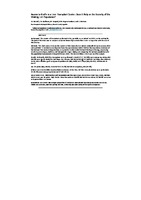Repositorio Digital
Access to grafts in a liver transplant Center: Does it rely on the severity of the waiting list population?
- DSpace Principal
- →
- Hospital El Cruce
- →
- Publicaciones
- →
- Artículos
- →
- Ver ítem
JavaScript is disabled for your browser. Some features of this site may not work without it.
Mostrar el registro sencillo del ítem
| dc.contributor.author | Daciuk, N. I. | |
| dc.contributor.author | Quiñonez, Emilio | |
| dc.contributor.author | Poupard, M | |
| dc.contributor.author | Sandoval, R. M. Vergara | |
| dc.contributor.author | Mattera, Francisco Juan | |
| dc.date.accessioned | 2018-05-15T17:46:32Z | |
| dc.date.available | 2018-05-15T17:46:32Z | |
| dc.date.issued | 2018-03-01 | |
| dc.identifier.issn | 0041-1345/18 | |
| dc.identifier.other | 10.1016/j.transproceed.2017.12.049 | |
| dc.identifier.uri | https://doi.org/10.1016/j.transproceed.2017.12.049 | |
| dc.identifier.uri | http://repositorio.hospitalelcruce.org/xmlui/handle/123456789/692 | |
| dc.description | Fil: Daciuk, NI. Hospital de Alta Complejidad en Red El Cruce Dr. Néstor C. Kirchner. Unidad de Trasplante hepático y Cirugia hepatobiliar. Florencio Varela, Argentina. | es_AR |
| dc.description.abstract | Background: The number of transplants performed relies, partially, on recipients' variables on the waiting list. The goal of this study was to compare recipients from a high-volume liver center in Argentina with the rest of the country. Methods: This study was a retrospective analysis of liver transplant recipients nationally between January 2013 and April 2017. It involved extracting data from the open database CRESI-SINTRA (the Argentinian database of the National Procurement Organization, an equivalent to the United Network for Organ Sharing); expressing results by percentages, medians, and interquartile ranges (IQRs); and comparing the national population with the population transplanted at Hospital El Cruce (HEC). The Mann-Whitney U test was used for analysis. Results: Nationally, 1434 liver transplants were performed. A total of 177 (12.34%) were emergency status; 811 (56.6%) were by the Model for End-Stage Liver Disease (MELD) (n = 759)/PELD (Pediatric End-Stage Liver Disease) (n = 52), with a median graft assignment position of 5 (IQR, 3–10) in 57.2 days (IQR, 11–217). Median MELD access was 29 points (IQR, 24–33). A total of 446 (31.1%) had MELD exceptions; 249 (55.8%) of these were due to Milan hepatocellular carcinoma. At the HEC, 167 liver transplantations were performed; 26 (15.6%) were emergency status and 97 (58.1%) by MELD (none PELD). Their median graft assignment position was 4 (IQR, 4–16) in 19.1 days (IQR, 4–90); median MELD access was 28 points (IQR, 24–31). Forty-five patients (26.9%) had MELD exceptions; 31 (68.9%) were due to hepatocellular carcinoma. Conclusions: Our center has a larger proportion of recipients transplanted by emergency status and MELD, similar MELD access, and less waiting list time, reflecting our wide policy of liver graft acceptance. | es_AR |
| dc.language.iso | en | es_AR |
| dc.publisher | Elsevier | es_AR |
| dc.relation.ispartofseries | Transplantation Proceedings; | |
| dc.subject | Trasplante de Hígado | es_AR |
| dc.subject | Liver Transplantation | es_AR |
| dc.subject | Argentina | es_AR |
| dc.subject | Características de la Población | es_AR |
| dc.subject | Population Characteristics | es_AR |
| dc.title | Access to grafts in a liver transplant Center: Does it rely on the severity of the waiting list population? | es_AR |
| dc.type | Article | es_AR |
Ficheros en el ítem
Este ítem aparece en la(s) siguiente(s) colección(ones)
-
Artículos
Articles

